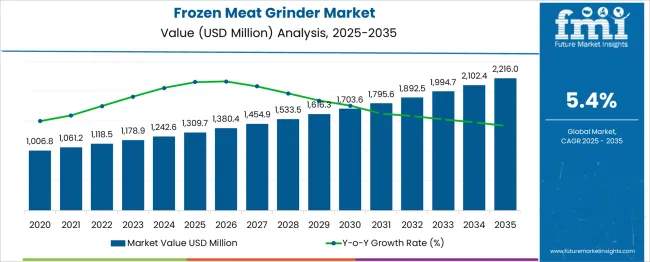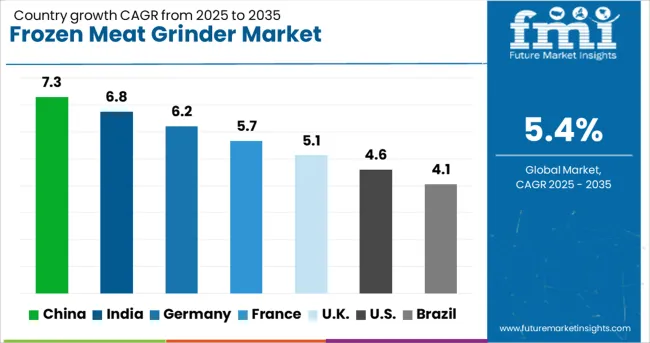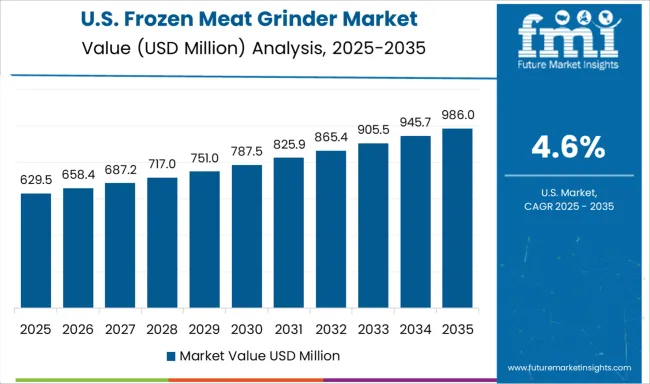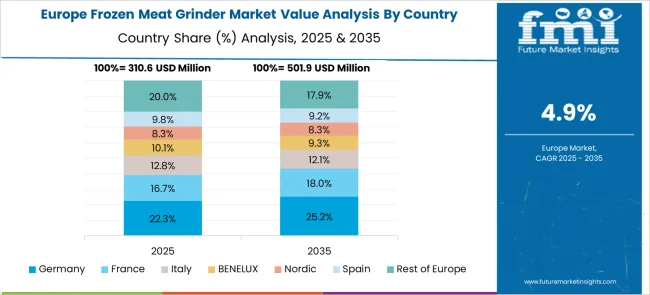The Frozen Meat Grinder Market is estimated to be valued at USD 1309.7 million in 2025 and is projected to reach USD 2216.0 million by 2035, registering a compound annual growth rate (CAGR) of 5.4% over the forecast period.

| Metric | Value |
|---|---|
| Frozen Meat Grinder Market Estimated Value in (2025 E) | USD 1309.7 million |
| Frozen Meat Grinder Market Forecast Value in (2035 F) | USD 2216.0 million |
| Forecast CAGR (2025 to 2035) | 5.4% |
As per Future Market Insights, the global frozen meat grinders market grew at a significant rate over the past half-decade owing to the rising consumption of non-vegetarian food products across the globe.
In the meat processing industry, frozen meat is preferred over fresh meat since processing creates heat, which can deteriorate fresh meat. As a result, frozen meat is utilized in the food processing sector for superior and ultimate quality sausages, meatballs, pet food, and other meat products.
The fastest growth is expected to be in low- and middle-income countries owing to the increasing meat demand across Brazil, China, and India. According to the UN Food and Agriculture Organization, worldwide meat consumption will increase by more than 1% in 2025.


The USA Frozen Meat Grinder Market to Account for Nearly 4/5th of Sales in North America
As per FMI, sales of frozen meat grinder in the USA will increase at a CAGR of 7.1%, accounting for market share of 76.1% in North America. The idea of freezing meat before grinding it to make it easier to process originated in the USA
Growing urbanization and rising meat-consumption have resulted in a strong demand for technology that can prepare meat more quickly while maintaining its original flavor. Replacement or conversion to new, more efficient equipment is swift in the USA, resulting in increased sales.
Presence of Numerous Hotels and Slaughterhouses to Push the Demand for Frozen Meat Grinders
With increasing number of hotels, restaurants, and slaughterhouses, China is considered as one of the key markets for the frozen meat grinder. This market is predicted to increase at a CAGR of 7.4%, paving the door for hotels and restaurants to adopt worldwide standard meat grinding equipment.

Advent of Automation in Food Service Industry to Boost Frozen Meat Grinder Market
Germany frozen meat grinder market will grow at a CAGR of 9.6%, holding around 31.1% of market share in Europe. With rising awareness about health benefits of meat grinders on their own, the market is expected to grow in the coming decade.
Restaurants in Germany prefer to use their minced meat blend to reduce fat content. With integration of automation in Germany, preferences are shifting toward high-performance equipment, which is likely to drive frozen meat grinder sales during the assessment period.
India to be the Hub for Frozen Meat Grinder Market Players
India frozen meat grinder market is projected to exhibit growth at a CAGR of 6.2%, with over 49.3% of market share in South Asia. Meat goods have a short shelf life, and logistics of such perishable products in locations outside of the mainstream are difficult.
Freezing meat below a negative temperature is a solution, however, the equipment required to mince such hard meat products is not inexpensive. India is one of the leading exporters of frozen meat grinders due to low-cost raw materials such as stainless steel and improved designs of commercial frozen meat grinders combined with low labor expenses.
Countertop Frozen Meat Grinders to be the Most Preferred by End Users
The frozen meat grinder market was dominated by countertop frozen meat grinders. In the coming decade, factors such as the availability of frozen meat grinders tailored to the needs of supermarkets and food service establishments, as well as perks such as the usage of less energy, will aid the growth of this industrial segment.
A countertop frozen meat grinder is a small, light version that may be used on a workbench or a counter. This factor contributes to the equipment's increased use because of its user-friendliness but it just has a tiny grinding area and isn't designed to butcher large pieces of meat.
Demand for Frozen Meat Grinders in Pet Food Processing Industry to Improve Sales
Frozen meat grinders are becoming increasingly popular in the commercial sector. This is due to an increase in the demand for processed and packaged foods. Grinders are used in the pet food manufacturing business to mix and make suitable minced meat that is ready to feed with a balanced amount of fat content.
Frozen meat grinders are used to chop huge portions of meat into smaller, more manageable pieces that can be processed or cooked later. They're also used to make delicacies like roast beef, ham, and turkey in restaurants and hotels. Due to the obvious growing demand for processed meat products around the world, commercial frozen meat grinder manufacturers have improved their designs to attract more customers.
Semi-Automatic Frozen Meat Grinders to Gain More Traction through 2035
Since semi-automatic grinders are less expensive and can be employed in emerging economies with minimal labor expenses. The revolving blade is used to cut the frozen disc, install the frozen disc and slice it into pieces, push the meat from the hopper to the reamer box's pre-cut orifice plate, and use the revolving chopping blade and orifice blade.
All this requires careful, skilled, and trained labor to get the best output. They're common in hotels, restaurants, food processing plants, and butcher shops. In developing countries, such equipment is in use due to its long shelf life and easy logistics of meat products.
Frozen meat grinders are used in small-scale, medium-scale, and large-scale operations to process meat. The increased use of various meat products has increased the demand for meat grinders all over the world.
Ecommerce to Account for Significant Portion of Frozen Meat Grinder Market
When it comes to placing these orders, 44% prefer to do it through a supplier's e-commerce site. Excellent time and information management are critical in the food and beverage industry for a positive customer experience and a smooth purchasing path, as well as decreasing waste and increasing the quality of supplied perishable commodities.
Buyers require information about when things are available for purchase and when they will be delivered. Barsso, GEA Food Solutions, Paul Kolbe GmbH, and many others maintain an active website for enquiring about and ordering equipment.
Key players are pursuing a variety of methods, including mergers and acquisitions to gain competitive edge. Furthermore, numerous significant firms are working on new product launches and development to expand their capacity and get a foothold in the business.
For Example,
| Attribute | Details |
|---|---|
| Forecast Period | 2025 to 2035 |
| Historical Data Available for | 2020 to 2024 |
| Market Analysis | USD Million for Value & Unit for Volume |
| Key Regions Covered | North America; Latin America; Europe; East Asia; South Asia; Oceania; Middle East & Africa |
| Key Countries Covered | The USA, Canada, Brazil, Mexico, Chile, Peru, Germany, The UK, France, Spain, Italy, BENELUX, Nordic, Poland, Russia, China, Japan, South Korea, India, Thailand, Indonesia, Malaysia, Singapore, Australia, New Zealand, South Africa, North Africa, GCC Countries |
| Key Segments Covered | Equipment Type, Types, End-User, Power, Region |
| Key Companies Profiled | Barsso; ERBEL GmbH; GEA Food Solutions; Paul Kolbe GmbH; Hobart; Skyfood Equipment; Minerva Omega Group; BIRO Manufacturing; ITW Food Equipment Group; KitchenWare Station LLC.; LEM Products; Marel; Sirman SpA; Avantco Equipment; Brice Australia; Others |
The global frozen meat grinder market is estimated to be valued at USD 1,309.7 million in 2025.
The market size for the frozen meat grinder market is projected to reach USD 2,216.0 million by 2035.
The frozen meat grinder market is expected to grow at a 5.4% CAGR between 2025 and 2035.
The key product types in frozen meat grinder market are floor - model and countertop.
In terms of type, semi - automatic segment to command 63.8% share in the frozen meat grinder market in 2025.






Full Research Suite comprises of:
Market outlook & trends analysis
Interviews & case studies
Strategic recommendations
Vendor profiles & capabilities analysis
5-year forecasts
8 regions and 60+ country-level data splits
Market segment data splits
12 months of continuous data updates
DELIVERED AS:
PDF EXCEL ONLINE
Frozen Pet Food Market Size and Share Forecast Outlook 2025 to 2035
Frozen Yogurt Market Size and Share Forecast Outlook 2025 to 2035
Frozen Egg Market Size and Share Forecast Outlook 2025 to 2035
Frozen Food Packaging Market Size and Share Forecast Outlook 2025 to 2035
Frozen Tissues Samples Market Size and Share Forecast Outlook 2025 to 2035
Frozen Food Packaging Machines Market Size and Share Forecast Outlook 2025 to 2035
Frozen Food Market Analysis - Size, Share, and Forecast Outlook 2025 to 2035
Frozen Pastries Market Size and Share Forecast Outlook 2025 to 2035
Frozen Baked Goods Market Size and Share Forecast Outlook 2025 to 2035
Frozen Potatoes Market Size and Share Forecast Outlook 2025 to 2035
Frozen Beverage Dispenser Market Size and Share Forecast Outlook 2025 to 2035
Frozen Fruits and Vegetables Market Size and Share Forecast Outlook 2025 to 2035
Frozen Vegetable Market Analysis - Size, Share, and Forecast Outlook 2025 to 2035
Frozen Cheese Market Size and Share Forecast Outlook 2025 to 2035
Frozen Snacks Market Analysis - Size, Share, and Forecast Outlook for 2025 to 2035
Frozen Fruit Bars Market Analysis - Size and Share Forecast Outlook 2025 to 2035
Frozen Desserts Market Growth Share Trends 2025 to 2035
Frozen Ready Meals Market Analysis - Size, Share, and Forecast Outlook 2025 to 2035
Frozen Tortilla Market Size, Growth, and Forecast for 2025 to 2035
Market Share Insights in the Frozen Food Industry

Thank you!
You will receive an email from our Business Development Manager. Please be sure to check your SPAM/JUNK folder too.
Chat With
MaRIA